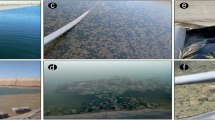Abstract
Studies of the seasonal distribution of heterotrophic bacteria in Chesapeake Bay (USA) led us to the observation that fungizone was selective for actinomycetes without appreciably altering the total viable aerobic, heterotrophic bacterial counts. A study of the actinomycete populations in the Bay was undertaken, with several media compared for ability to enrich for actinomycetes: basal, casein, Czapek, starch-casein, glycerol-glycine, chitin and oil agar No. 2. Between 40 and 100% of the colonies appearing on chitin and oil No. 2 media were found to be actinomycetes, compared with <2% for the other media employed. It was also found that if sediment samples are frozen, a practice followed when laboratory facilities are not available in the field, a decrease in the total counts and in the actinomycete colony counts occurred. However, on a proportional basis, a slight increase in the percent actinomycetes was noted. A minimum of 21 days incubation time is recommended for recovery of actinomycetes. Also, the absence of NaCl from the actinomycete isolation media and incubation temperatures ≥15°C should give good recoveries of actinomycetes. A seasonal distribution of actinomycetes was noted for Chesapeake Bay, with maximal populations of actinomycetes observed in March and November. Actinomycetes were isolated in the ocean from depths ranging from 7 to 7,790 m. Greater numbers of actinomycetes were isolated using an incubation temperature of 25°C for the estuarine stations and 15°C for the deep-ocean stations. Greater numbers of actinomycetes were associated with polluted environments close to shore.
Similar content being viewed by others
Literature Cited
Aaronson, S.: Experimental microbial ecology, 236 pp. New York: Academic Press 1970
Bolwell, R.R., J.D. Nelson and J.D. Walker: Microbial mobilization of nutrients in estuaries. Second International Estuarine Research Conference. Myrtle Beach, South Carolina: In press
Grein, A. and S.P. Meyers: Growth characteristics and antibiotic production of actinomycetes isolated from littoral sediments and materials suspended in seawater. J. Bact. 76, 457–463 (1958)
Humm, H.J. and K.S. Shepard: Three new agardigesting actinomycetes. Bull. Duke Univ. mar. Stn 3, 76–80 (1946)
Lindenbein, W.: Über einige chemische interessante Aktinomycetenstämme und ihre Klassifizierung. Arch. Mikrobiol. 17, 361–383 (1952)
Lingappa, Y. and J.L. Lockwood: Superior media for isolation of actinomycetes from soil. Phytopathology 50, p. 644 (1960)
Okazaki, T. and Y. Okami: Studies on marine microorganisms. II. Actinomycetes in Sagami Bay and their antibiotic substances. J. Antibiot., Tokyo (Ser. A) 25, 461–466 (1972)
Roach, A.W. and J.K.G. Silvey: The occurrence of marine actinomycetes in Texas Gulf Coast substrates. Am. Midl. Nat. 62, 482–499 (1959)
Saito, T.: Soil microflora of a coastal dune. Sci. Rep. Tôhoku Univ. 21, 145–151 (1955)
Sizemore, R.K. and L.H. Stevenson: Method for isolation of proteolytic marine bacteria. Appl. Microbiol. 20, 991–992 (1970)
Solovieva, N.K.: Actinomycetes of littoral and sublittoral zones of the White Sea. Antibiotiki 17, 387–392 (1972)
Walker, J.D., J.J. Calomiris, T.L. Herbert and R.R. Colwell: Petroleum hydrocarbons: growth and degradation potential for marine sediment bacteria. (In preparation)
— and R.R. Colwell: Microbial ecology of petroleum utilization in Chesapeake Bay. In: Proceedings of API/EPA/USCG Conference on Prevention and Control of Oil Spills, pp 821–825. Washington: American Petroleum Institute 1973
Watson, E.T. and S.T. Williams: Studies on the ecology of actinomycetes in soil. VII. Actinomycetes in a coastal sand belt. Soil Biol. Biochem. 6, 43–52 (1974)
Webley, D.M., D.J. Eastwood and C.H. Gimingham: Development of a soil microflora in relation to plant succession on sand dunes, including the “rhizosphere” flora associated with colonising species. J. Ecol. 40, 168–178 (1952)
Weyland, H.: Actinomycetes in North Sea and Atlantic Ocean sediments. Nature, Lond. 223, p. 858 (1969)
Wood, E.J.F.: Heterotrophic bacteria in marine environments of Eastern Australia. Aust. J. mar. Freshwat. Res. 4, 160–200 (1953)
ZoBell, C.E., C.W. Grant and H.F. Haas: Marine microorganisms which oxidize petroleum hydrocarbons. Bull. Am. Ass. Petrol. Geol. 27, 1175–1193 (1943)
Author information
Authors and Affiliations
Additional information
Communicated by M.R. Tripp, Newark
Rights and permissions
About this article
Cite this article
Walker, J.D., Colwell, R.R. Factors affecting enumeration and isolation of actinomycetes from Chesapeake Bay and Southeastern Atlantic Ocean sediments. Marine Biology 30, 193–201 (1975). https://doi.org/10.1007/BF00390742
Accepted:
Issue Date:
DOI: https://doi.org/10.1007/BF00390742




